As we motored through the Rioja Alavesa wine country in northern Spain, a golden landscape dotted with hilltop monasteries, sweeping vineyards, and walled towns with window boxes overflowing with red geraniums, I reflected on what we had absorbed that day. In a region famed for wine we’d enjoyed much wonderful vino, of course, but we also took in a rich amount of history – everything from walking in a 1,000 year-old necropolis with burial plots chiseled out of rock, to diving deep into a wine cellar that was originally dug out to be an escape tunnel during times of war. We also mingled with winery owners possessing a respect for tradition, and a desire to incorporate forward-thinking, sustainable practices into their businesses.
On this trip, our second jaunt into Rioja, we explored three Rioja Alavesa wineries with fun-loving Carol, the owner of Thabuca Wine Tours. Carol is an enthusiastic globetrotter, a wine tourism pioneer, and a talented linguist who has perfected many languages. Our full day together visiting the Remelluri, Ostatu, and El Fabulista bodegas was made complete with an extraordinary six-course Basque lunch at La Bodega de Rivas, and book-ended with stops in the Old Towns of Labastida and Laguardia, which are rich with handsome cathedrals and buildings with sandstone façades.
Getting to Know Rioja
Rioja is divided into three sections: Rioja Alavesa (which is part of Spanish Basque Country), Rioja Alta, and Rioja Baja, each characterized by different microclimates, and soil types. Rioja’s wine-growing history dates back to the Phoenicians 3,000 years ago, with the Romans and French also leaving their mark on Rioja’s wine-growing past. Bodegas were set up by the Romans to supply their troops more than 1,900 years ago. And in the 1850s, French winemakers from Bordeaux, whose own vines were being ravaged by the Phylloxera epidemic, depended on Rioja for a supply of wine. In the process, they established wineries there and infused the region with innovating wine-growing know-how and money.
World Wars One and Two, coupled with the Spanish Civil War decimated Rioja’s wine industry and a famine prompted the government to mandate the conversion of the vineyards into wheat-growing fields. In the 1960s, winemakers slowly replanted the fields with vines, but it wasn’t until 1970 that Rioja experienced its turning point, when the wine world went abuzz over that year’s excellent vintage.
The region’s most well-known varietal is the Tempranillo grape, but other grapes are commonly blended in.
Remelluri Estate (officially, La Granja Nuestra Señora de Remelluri)
As Remelluri Estate owner Amaia shared her stunning estate’s history with us, she was so moved that she developed goosebumps, despite it being a hot summer’s day.
“I get the chills just thinking about it, because the movement to push the Arabs south started right here. It lasted for three centuries,” she said, as we began our exploration of one of Spain’s oldest wine-growing estates.
Remelluri’s namesake, Count Erramel, (uri means ‘town’ or ‘villa’ in Basque), Amaia explained, founded a settlement on the site of the present winery in the 10th and 11th centuries. Even today evidence of the community that Erramel established exists in the form of an ancient necropolis. It’s comprised of burial plots carved out of rock for the Christian warriors and their family members. As we visited this intriguing 1,000 year-old cemetery on the edge of Remelluri vineyards, we were pleased to see that a family with such a passionate interest in history and archaeology had become its caretaker, and that they were quite willing to share it with others.
Continuing our visit, Amaia drew our attention to a jagged mountain overlooking the property, explaining that in the 15th century, Jerónimo monks had established the Toloño Monastery there. Over time, they moved to lower ground so that they could grow grapes to make wine for mass.
As Amaia shared the area’s history, we mingled with the winery’s beloved donkeys, Juanita and Morenita, eventually meandering to a dramatic overlook that showcased the glorious landscape. We came to respect Remelluri’s philosophy too. They implemented organic farming techniques in 2010, and even partnered with an NGO to find laborers from countries such as Pakistan or Mali, where job opportunities are scarce. During our visit, laborers from a nonprofit organization were removing shoots from the vines, something that helps prevent disease. Though this process results in higher labor costs, and ultimately a pricier bottle of wine, Remelluri chooses this route to avoid using chemicals.
Before embarking on a delightful tasting on a quiet patio of the estate, we’d also visit Remelluri’s small museum and wine cellar, as well as its centuries-old chapel which features contemporary paintings of saints with a twist. Some of them depict Amaia and her family. Lavender and thyme bushes outside scented the dry air.
We reluctantly left Remelluri, yearning to soon return so that we can hike the gorgeous grounds, and then again relax with a glass of Remelluri Reserva in hand.
- 2010 Lindes de Remelluri San Vincente, 14.25% alcohol content. Hand-picked Tempranillo, Garnacha and Graciano grapes aged in French and American oak barrels for 10 months.
- 2009 Remelluri Reserva, 14% alcohol content. Hand-picked Tempranillo, Garnacha and Graciano grapes aged in French oak barrels for 16 months. Had a pleasing dark-red color and was more full-bodied than the first wine tasted.
La Bodega de Rivas Restaurant
Next we journeyed to the tiny town of Rivas de Tereso, where Chef Raúl and his wife Laura opened the elegant, yet cozy La Bodega de Rivas restaurant last fall. The couple was so busy ensuring their lunchtime customers were well-pampered, that we didn’t get a chance to talk with them at great length, with Carol acting as translator. Nevertheless, their genuine smiles radiated kindness, and the impeccably-presented dishes – many of which were renewed versions of traditional Basque cuisine – reflected Chef Raúl’s talent and creativity.
After our Cortados arrived at the table (an espresso cut with warm milk), we were so thoroughly relaxed that an unusual wave of silence fell over the table.
“We have an expression in Spanish that an ‘angel flies over when it’s quiet,'” Carol joked.
Indeed, the dining experience had been heavenly!
- 2013 El Primavera, 14% alcohol content, made with 100% Tempranillo grapes. Had lovely fruity flavors, and an effervescent texture.
- Artichokes & Potato Cream (Tricia) and Txistorra (Basque sausage) dipped in sauce (Shawn).
- Cream cheese Topped with Alfalfa Sprouts and Salmon
- Delicately-Cooked Egg in a Potato-Cream Sauce, with Truffle Shavings
- Iberico Pork in a Wine Sauce & Cauliflower Purée (Shawn)
- Codfish with Pisto Sauce: Tomatoes, Green Peppers, & Crab (Tricia)
- Homemade Apricot Ice Cream in a White Chocolate Soup
Ostatu Winery
En route to the family-owned Ostatu, we passed traditional stone-fronted bodegas, juxtaposed with cutting-edge architectural styles – some featuring sparkling glass, and angular designs. Bodega Ostatu, as we would learn, is somewhere in between.
Originally a hotel and a popular stopping place in a remote area during the 18th century, the Ostatu Winery was originally the home of María Asun and her siblings. In 2009, however, the building underwent a renovation, streamlining its interior.
“My family’s philosophy is based on producing quality wines – not quantity,” María Asun said, as she pointed to some of the Ostatu vines across the street from the tasting room. The family employs eco-friendly techniques, something that earned the winery emission-neutral status in 2012.
“Our grapes are grown on different plots of land – we have about 34 hectares divided among 50 or so plots.”
The common thread for all the plots, María Asun explained, is the Sierra de Cantabria Mountain ridge, which acts as a buffer zone between the region’s Atlantic and Mediterranean climates and protects the vines from cold, northerly winds.
Unfortunately, we were running short on time and not able to fully tour the Ostatu property, nevertheless we enjoyed a very pleasant tasting in the colorful courtyard of the winery, while María Asun’s children, recently returned from school and helping tend to the flowers, shyly exchanged curious smiles with us.
- 2011 Ostatu Lore, 13.5% alcohol content. Hand-picked grapes: 50% Viura and 50% Malvasia. Still young, but nice potential for aging.
- 2009 Ostatu Laderas, 14% alcohol content. Hand-picked grapes: 97% Tempranillo, and 3% Viura, aged for 13 months in oak. Brilliant garnet color. Fruity; we even detected some black pepper notes.
El Fabulista Winery
Trading Rioja Alavesa’s open fields for cobblestone lanes, we landed at our last wine tasting stop at El Fabulista, in the walled town of Laguardia. Met by the winery’s outgoing employee Mar, we learned that the building was formerly a palace, and once home to famous fable author, Félix María de Samaniego. Today, the labels at the traditional winery bear the likeness of his fables’ characters, and even contain snippets of his tales.
Of the 300 or so underground cellars in Laguardia, El Fabulista is only one of two that still produces wine in the city.
“Our grapes are picked by hand, and we still stomp on them,” Mar explained, as she pointed to the wine-pressing room.
Descending into the underground cellars, we were surrounded by 800-year-old stones on the walls and ceiling.
“Laguardia’s cellars were originally used as an underground cave from which to escape during times of war,” Mar explained. It wasn’t until the 16th or 17th centuries that residents started using them for wine production.”
Adding further incentive to return to Rioja, Mar added, with a smile,”Visitors are welcome to come to El Fabulista during the harvest season and help with the stomping of the grapes.”
- 2011 El Fabulista Illustrado, 14 % alcohol content. Aged for 6 months in American oak. Hints of brown sugar.
- 2011 El Fabulista Sabio, 14% alcohol content. Aged for 14 months in American and French oak. Detected strong, grassy notes.
***
If you visit Rioja Alavesa, and perhaps join Carol on one of her tours, I’d love to know what you think. Or, if you’ve already been to Rioja’s wine country, I’d be curious to hear all about your favorite bodegas.
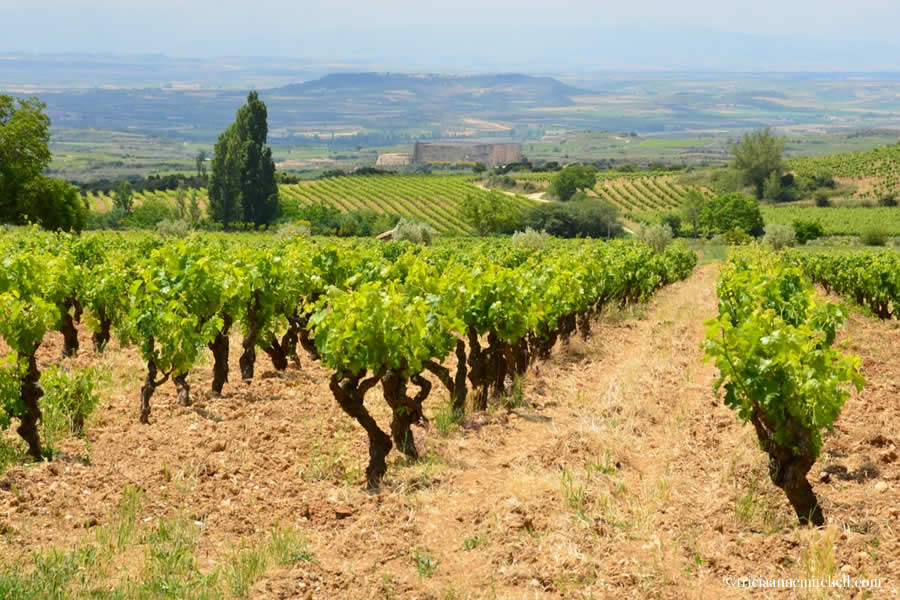
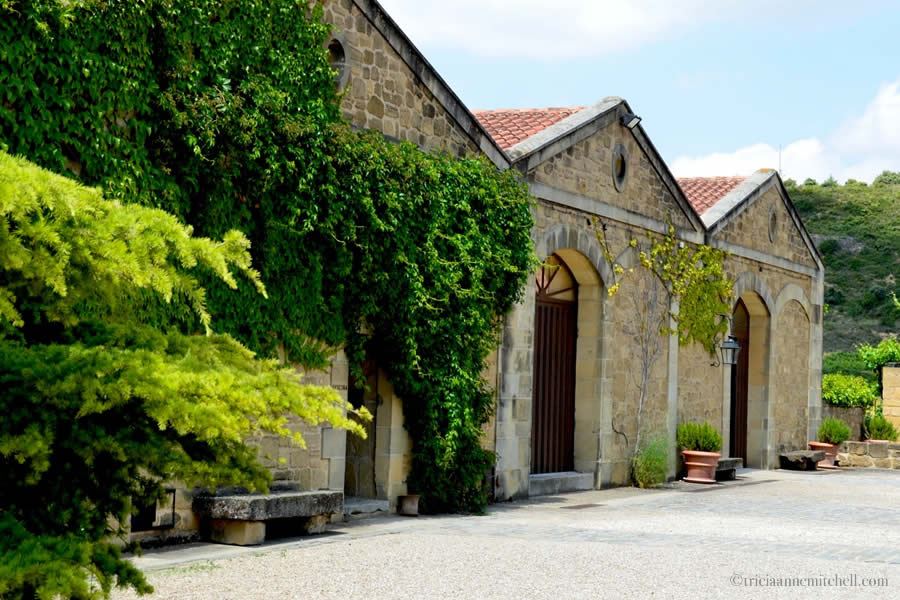









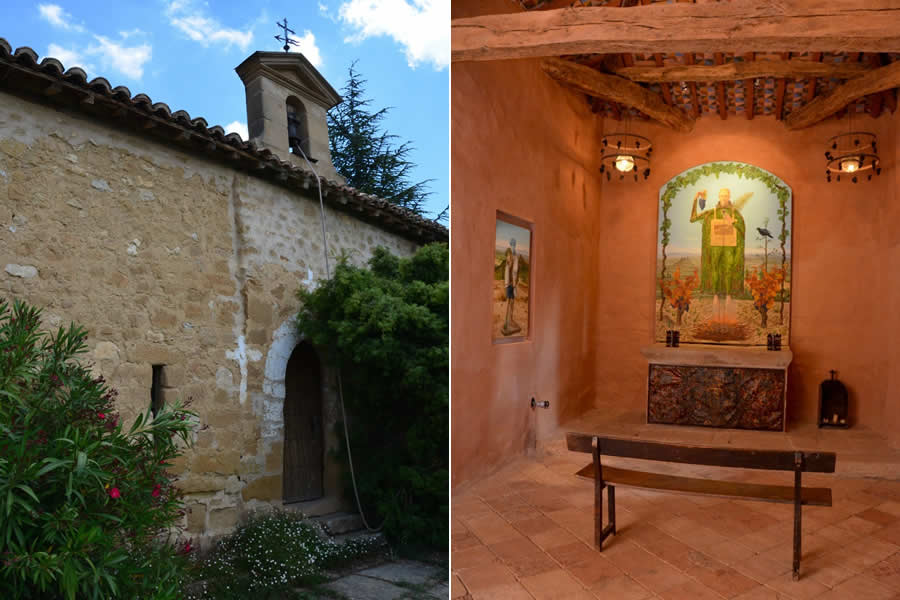






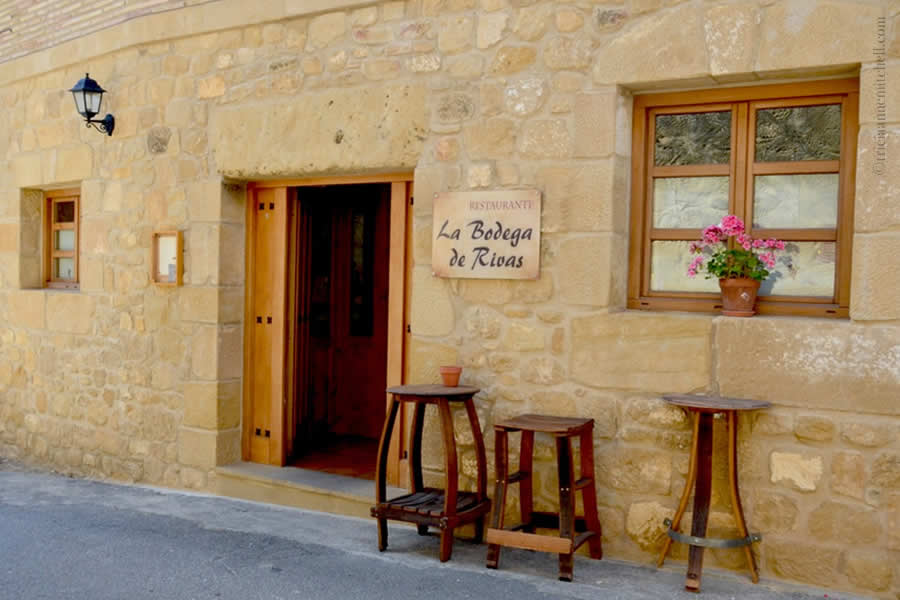
















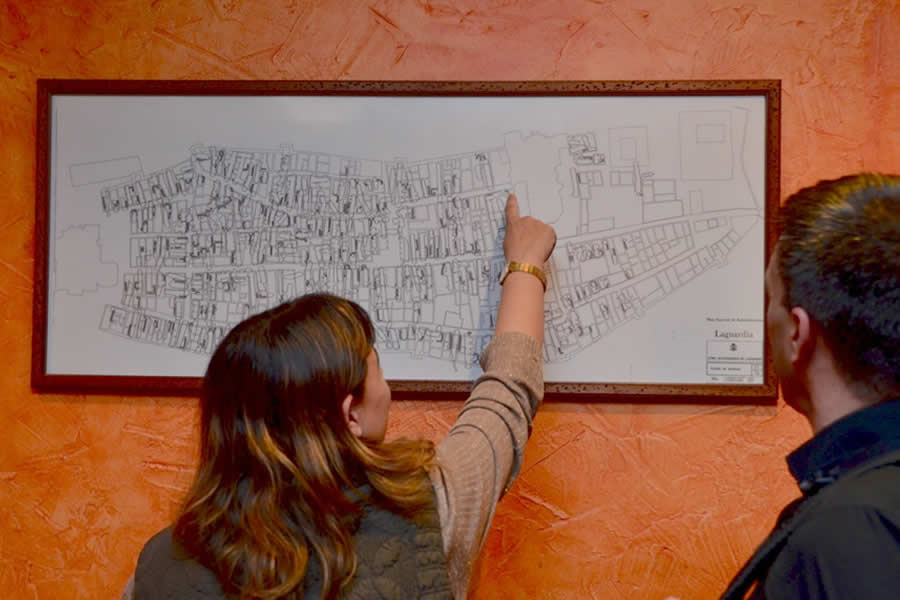



Our Video of this Experience:
Where in the World?
Planning Pointers:
- Rioja wine country is divided into three sections: Rioja Alavesa, Rioja Alta, and Rioja Baja. During this full-day excursion with Thabuca Wine Tours, we focused solely on Rioja Alavesa wineries. Thabuca’s owner, Carol, tailored our trip to our interests and my dietary needs (gluten-free and ‘selectarian’ meat preferences). Along with her driver, they escorted us door-to-door, allowing us to have a carefree and educational tasting experience, with no worries about responsible driving. (Earlier on in our Spain trip, when we’d explored Rioja wine country with Shawn’s parents, we learned that it’s wise to make tasting reservations in advance, as some wineries were otherwise closed. It was lovely having Carol do all that research for us the second time around.)
- Rioja Alavesa is about 115 km. (70 miles) from Bilbao, which we used as our base of operations.
- Need more inspiration? This link contains an index of all my posts from Spain.
Disclosure & Thanks:
Thabuca Wine Tours provided us with this day trip in Rioja Alavesa’s wine country.
We’d like to extend a special thank you to Carol for hosting us. Our day also wouldn’t have been the same without Amaia, María Asun, Mar, Chef Raúl, Laura and chauffeur, Marta.
Photography & text © Tricia A. Mitchell. All Rights Reserved. Video footage is courtesy of my husband, Shawn.

What a superb day you must have had! I used to work in the wine trade in the U.K. and many years ago, while on holiday in northern Spain, I visited the spellbinding town of Laguardia as a day trip from Logroño. As a wine retailer, with a quick phone call, I managed to set up visits to Bodegas Palacio and Campillo – both in or very near Laguardia. I was treated like royalty and yet still had time to explore the old town – and see the stork nesting on the cathedral – before the bus home. Fantastic.
Hi Jon – what a fun industry in which to work! We visited Laguardia twice – once on a weekend when it was bustling with visitors, and then on this trip with Carol during the week, which was much more laid-back. Though we didn’t see the stork you mentioned, we were wowed by the town’s history.
In Logroño did you take in your fair share of tapas? We loved that there were so many tapas bars crammed into one part of the Old Town!
We were both indeed lucky to scratch the surface in Rioja, and because there is much more history to be discovered there – and of course good wine to sample – I hope to return someday soon.
Thanks for your thoughtful comment and for sharing your experience!
Wow, day of dreams!
Angeline, indeed! It was one of those experiences where we’ve stopped and said how lucky we are to be meeting such wonderful people, and learning from the journey.
Amazing post as always. What a great experience.
Hi Darlene, nice of you to stop by. Indeed, it was a special day, thanks to the locals who shared their slice of Rioja with us. :)
It looks like you had a very good time that was also very interesting. The food must have been delicious. The wine must have been very very good. It is very beautiful over there.
Thank you for sharing.
Greetings Gerard! The world has many notable wine-growing regions, but what makes Europe’s so intriguing to me is all this history. I found the necropolis at the first winery to be especially fascinating!
From pintxos to fine dining, Spain’s Basque Country does take its dining seriously. We learned that the men even participate in Txokos, which are gastronomical societies open only to men. I’m quite happy with Shawn’s cooking so I won’t be enrolling him any time soon. :)
Regards form Basque Country
http://blog.aboutbc.info/2014/08/13/una-ilustradora-visita-a-la-rioja-alavesa-de-un-matrimonio-viajero-norteamericano-con-video/
Greetings, and eskerrik asko – thank you – for sharing our experiences in Basque Country with your readers. Bilbao and Rioja Alavesa were a nice introduction to the region, and we hope that we’ll someday soon have the opportunity to return and explore more of Euskadi. I’d especially like to see more of the coastal areas.
A brilliant post…I could almost taste the wine & food (I love Spanish wine, perhaps more for the ‘feel of Spain’ that I think about when I drink it). Another great series of photos. The positive envy continues with your work :-)
Randall, as they say in Basque Country, eskerrik asko – thanks. :) Do you have any particular favorites when it comes to Spanish wine? We tasted some noteworthy wine in Spain, but what really stood out for me in Rioja Alavesa wine country was all the history – particularly at the first winery I profiled here. I appreciated that one could not only taste wine there, but also stroll its 1,000-year-old necropolis, or hike up to the ruins of a monastery. Somehow it feels good being part of all that history, even if only for a few hours.